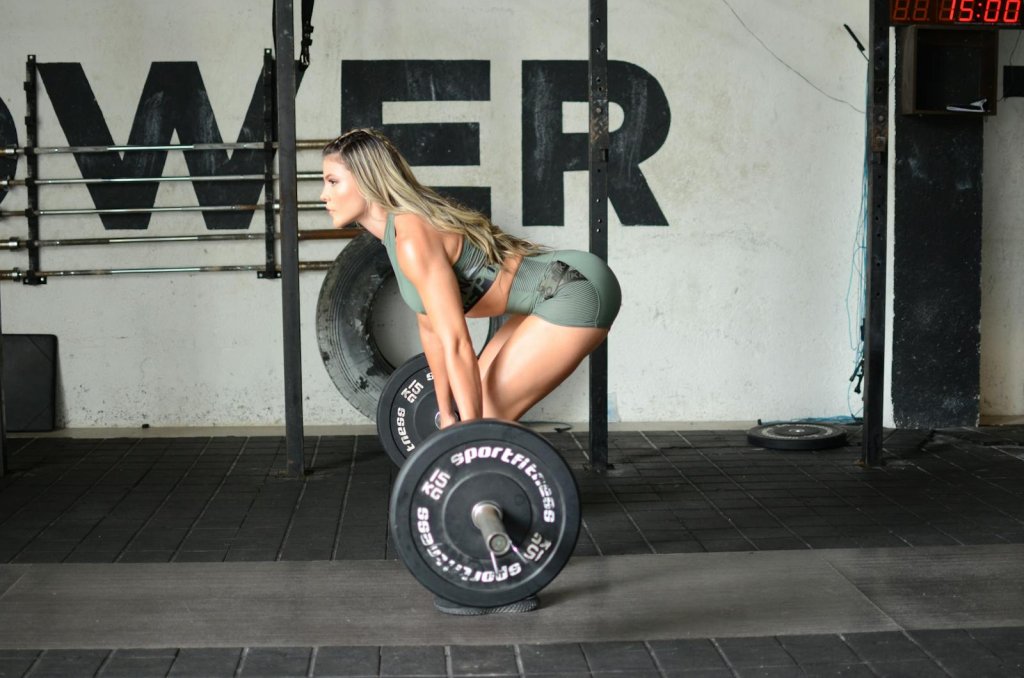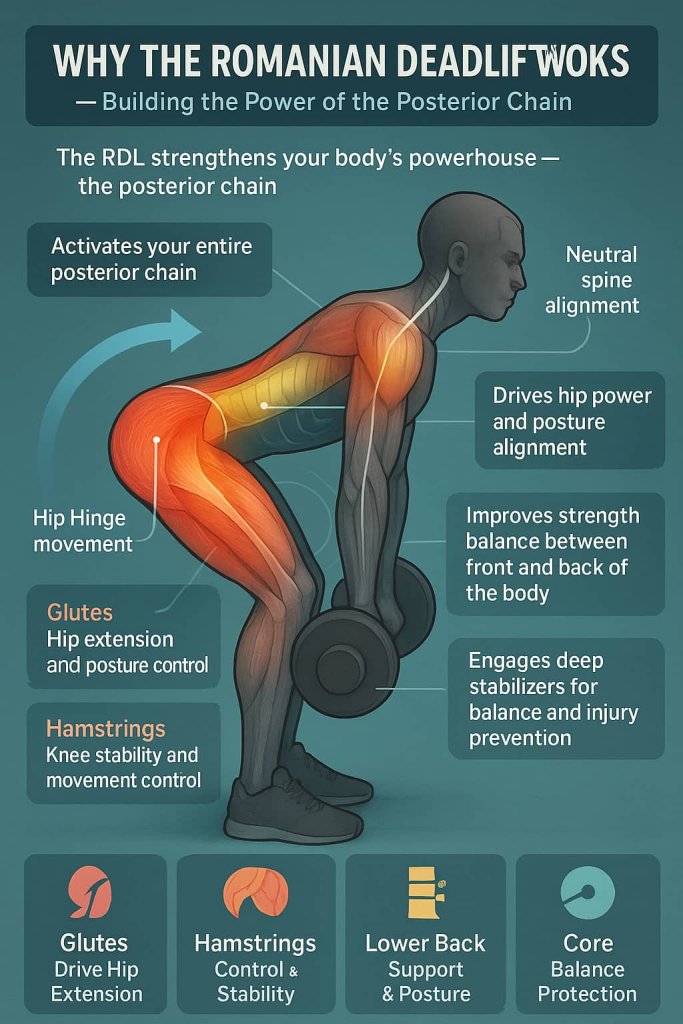The Romanian Deadlift (RDL) is one of the most effective exercises to strengthen your glutes, hamstrings, and lower back — the foundation of your posterior chain.
It builds power, balance, and posture while protecting your spine from strain.

Understanding how to perform and program the Romanian Deadlift correctly can dramatically improve your athletic performance, posture, and injury resilience. Whether you’re an athlete, lifter, or beginner, mastering this move will change how you train your lower body forever.
What Is the Romanian Deadlift?
The Romanian Deadlift (RDL) is a hip-hinge movement that targets the muscles on the backside of your body — glutes, hamstrings, and erector spinae — through controlled lowering and lifting of weight.
Unlike a conventional deadlift, the RDL starts from a standing position and emphasizes eccentric (lowering) control, not pulling from the floor.

This makes it ideal for improving flexibility, balance, and strength without excessive spinal compression.
Key Benefits:
- Strengthens hamstrings and glutes for athletic power
- Improves posture and hip stability
- Enhances mobility and balance
- Reduces risk of back and hamstring injuries
Authoritative coaching guidance and EMG data support the Romanian deadlift as a foundational hip-hinge for developing posterior-chain alignment and strength: the NSCA classifies the RDL as a hip-dominant hinge with the bar kept close to the body, and EMG research shows high activation of the hamstrings, gluteus maximus, and erector spinae throughout the lift.
Why the Romanian Deadlift Works
The RDL isolates the posterior chain — your body’s powerhouse for movement and stability.
By maintaining a neutral spine and driving through the hips, it activates muscles that are often neglected by squat-dominant routines.

How It Strengthens Your Body:
- Glutes: Drive hip extension and improve posture alignment.
- Hamstrings: Control knee flexion and stabilize movement during walking, sprinting, or lifting.
- Lower back: Strengthens erector spinae for spinal stability and posture.
- Core: Engages deep stabilizers for balance and injury prevention.
Evidence indicates that hip-dominant training such as the Romanian Deadlift meaningfully targets the hamstrings and glutes, and emerging trials are directly comparing hip-dominant (RDL) vs knee-dominant (Nordic) approaches for morphology, strength, and sprint performance (trial protocol), while field data show single-leg RDL warm-ups can lower hamstring-strain risk.
These muscles work together to create a strong and stable foundation — essential for posture, power, and injury prevention.
How to Do the Romanian Deadlift (Step-by-Step)
- Setup:
- Stand tall holding a barbell or dumbbells in front of your thighs.
- Keep feet hip-width apart, knees slightly bent, and chest open.
- Hinge:
- Push your hips back while keeping the bar close to your legs.
- Maintain a flat back and tight core; your torso leans forward as hips move backward.
- Lower:
- Lower the weight until you feel a deep stretch in your hamstrings (around mid-shin).
- Keep shoulders retracted and spine neutral.
- Return:
- Drive your hips forward to return to the starting position.
- Squeeze your glutes at the top.
- Repeat for 8–12 reps, focusing on control, not momentum.
Trainer Tip
- Keep the bar or dumbbells close to your body throughout the movement.
- Don’t over-bend the knees — the RDL is hip-dominant, not a squat.
- Maintain a neutral spine — avoid rounding your lower back.
- Focus on slow lowering (3–4 seconds) to maximize muscle engagement.
Muscles Worked in the Romanian Deadlift
| Primary Muscles | Supporting Muscles |
|---|---|
| Hamstrings (biceps femoris, semitendinosus, semimembranosus) | Erector spinae |
| Gluteus maximus | Core stabilizers (transverse abdominis, obliques) |
| Adductor magnus | Forearms and grip muscles |
Common Mistakes to Avoid
| Mistake | Correction |
|---|---|
| Rounding the lower back | Engage your core and retract shoulders |
| Bending knees too much | Slight bend only; movement comes from hips |
| Letting the bar drift away | Keep it close to legs for better leverage |
| Lifting too heavy too soon | Master form first, then add load gradually |
Variations of the Romanian Deadlift
1. Single-Leg Romanian Deadlift
Why it works:
This unilateral variation improves balance, coordination, and stability, training each side of the body independently to correct strength imbalances. It also enhances hamstring and glute engagement while challenging the core to maintain posture.
According to a 2025 International Journal of Sports Physical Therapy study, athletes who performed single-leg RDLs experienced over 60% fewer hamstring strain injuries, highlighting its importance for injury prevention and athletic performance.
Muscles worked:
- Hamstrings (especially biceps femoris)
- Gluteus maximus and medius
- Core stabilizers (obliques, transverse abdominis)
- Erector spinae (lower back)
How to do it:
- Stand on one leg with a slight bend in the knee, holding a dumbbell or kettlebell in the opposite hand.
- Hinge at the hips, extending your free leg straight back for balance.
- Lower the weight until you feel a stretch in your standing hamstring.
- Keep your torso and extended leg in one straight line.
- Drive through your heel to return to standing and repeat.
Trainer Tip:
Focus your eyes on a fixed point on the ground to help maintain balance. Move slowly — control is key to getting full engagement and avoiding wobbling.
2. Dumbbell Romanian Deadlift
Why it works:
Using dumbbells increases range of motion and freedom of movement, allowing for a deeper stretch in the hamstrings compared to a barbell. It also helps develop muscle symmetry and stability by engaging smaller stabilizer muscles on each side.
Muscles worked:
- Hamstrings and glutes
- Lower back (erector spinae)
- Forearms and grip muscles
- Core stabilizers
How to do it:
- Hold a dumbbell in each hand in front of your thighs.
- With soft knees, hinge at your hips while keeping the weights close to your legs.
- Lower until you feel a deep stretch in your hamstrings.
- Drive your hips forward to return to the starting position.
Trainer Tip:
Avoid letting the dumbbells drift forward — keep them aligned with your shins to maintain proper hip hinge mechanics and protect your lower back.
3. Barbell Romanian Deadlift
Why it works:
The barbell version allows for maximum load, making it ideal for developing strength and muscle mass in the posterior chain. It’s especially effective for athletes and powerlifters who want to build hip-dominant strength for better sprinting, jumping, and lifting performance.
Muscles worked:
- Gluteus maximus
- Hamstrings
- Erector spinae
- Core and lats (for stabilization)
How to do it:
- Stand with feet hip-width apart and barbell in front of your thighs.
- Keep your knees slightly bent and back straight.
- Push your hips back while lowering the bar close to your legs until mid-shin.
- Drive hips forward to stand tall, squeezing your glutes at the top.
Trainer Tip:
Engage your lats by slightly pulling the bar toward your body. This helps maintain control and keeps your spine neutral throughout the movement.
4. Banded Romanian Deadlift
Why it works:
Adding resistance bands introduces variable tension — making the lift harder as you approach the top of the movement, where your glutes are most active. This boosts explosive hip power and teaches full glute contraction through the entire range of motion.
Muscles worked:
- Gluteus maximus
- Hamstrings
- Lower back
- Core stabilizers
How to do it:
- Anchor a resistance band under your feet and loop it around the barbell or hold both ends with your hands.
- Perform a standard RDL by hinging at the hips and lowering the bar or band handles toward the floor.
- Drive your hips forward to stand tall, feeling increased tension as you rise.
Trainer Tip:
Maintain steady control against the band — don’t let it snap your movement upward. The goal is smooth tension, not momentum.
Programming: How Often to Do the RDL
- Frequency: 1–2 times per week
- Sets/Reps: 3–4 sets of 8–12 reps
- Rest: 60–90 seconds between sets
- Progression: Add resistance gradually every 1–2 weeks
For beginners, start with light dumbbells or a PVC pipe to learn proper hip hinge mechanics before loading heavy.
How to Integrate Romanian Deadlifts Into Your Routine
Include Romanian Deadlifts 1–2 times per week to build strength and balance in your posterior chain. Beginners can start once weekly with light weights and focus on form; advanced lifters can add a second day using heavier or single-leg variations.
When to do it:
Perform RDLs near the start of your lower-body workout, after your warm-up and before accessory lifts. Avoid doing them before sprinting or high-impact sessions.
Programming tips:
- Strength: 3–5 sets of 5–8 reps (heavy)
- Muscle growth: 3–4 sets of 8–12 reps (moderate)
- Mobility/control: 2–3 sets of 12–15 reps (light)
Pair RDLs with squats, hip thrusts, or planks for full lower-body balance.
Allow 48–72 hours of recovery between heavy sessions, and always warm up your hips and glutes before lifting.
Trainer Tip:
Progress slowly—add weight only when your form and hinge control stay solid through every rep.
Safety & Precautions
- Always warm up with dynamic stretches (leg swings, hip hinges).
- Avoid over-arching or rounding your back.
- If you feel back pain instead of a hamstring stretch, check your form or consult a certified trainer.
- People with chronic back injuries should get clearance from a physical therapist before adding RDLs to their program.
FAQs
1. What’s the difference between Romanian and conventional deadlifts?
RDLs start from the top and emphasize hamstrings and glutes, while conventional deadlifts start from the floor and involve more knee bend and total-body strength.
2. Can beginners do Romanian Deadlifts?
Yes — start with bodyweight or light dumbbells to master hip hinge form.
3. Do RDLs help posture?
Absolutely. Strengthening the posterior chain improves spinal alignment and reduces slouching.
4. How low should I go?
Lower only until you feel a stretch in your hamstrings without rounding your back — usually mid-shin level.
5. Are RDLs good for athletes?
Yes. They enhance sprint speed, power, and injury resistance — especially hamstring strain prevention.
6. Can I use kettlebells instead of a barbell?
Yes, kettlebells work well for balance and control training.
Conclusion
The Romanian Deadlift is more than just a leg exercise — it’s a movement that builds total-body balance, posture, and strength from the ground up.
By mastering this simple yet powerful hip-hinge pattern, you’ll improve performance, reduce injury risk, and unlock real, lasting strength.
Ready to build your foundation? Add RDLs to your next lower-body workout and feel the difference in every stride, lift, and movement.
